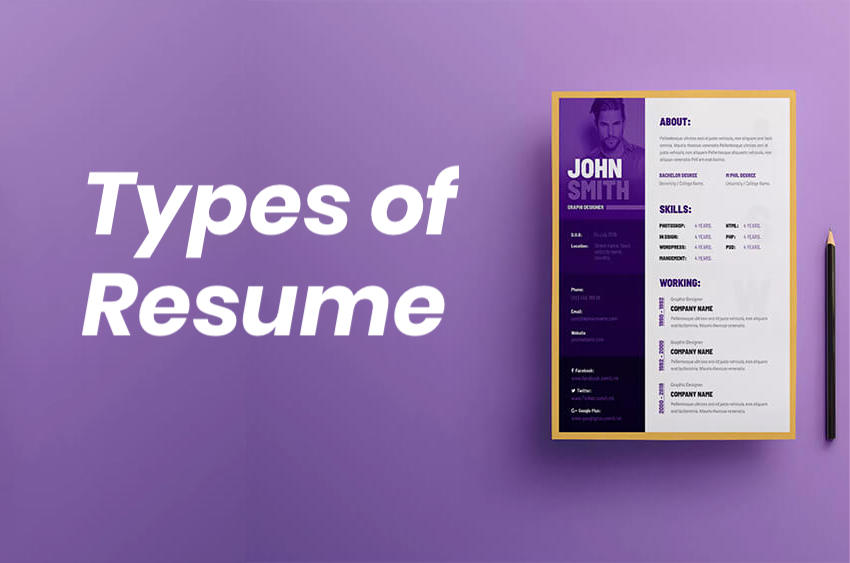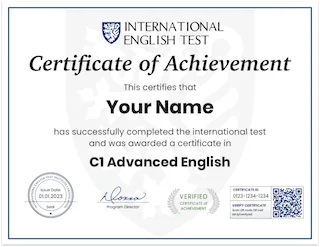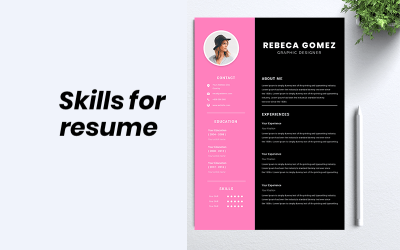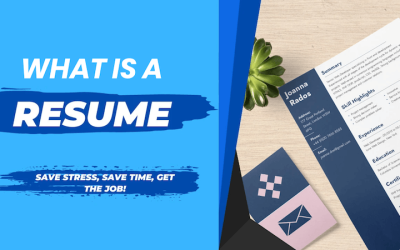The abundance of different resume formats can be perplexing, as it seems like the options are endless. The challenging part is that there might just be one right option. The stark contrast between a well-crafted resume and a mediocre one can be quite alarming, especially when you keep sending out resumes and receive nothing but silence in return.
In reality, the job market is highly competitive, and standing out among countless applicants requires a resume with a powerful impact, shaped by the right format that can land you the job.
But there’s no need to worry.
In this article, we will explore:
- The appearance and appropriate usage of traditional resume formats.
- A variety of resume formats for those seeking originality.
- How to determine the ideal length for your resume.
- Inspirational and beautiful resume designs to motivate you.
What is your English level?
Find out your A1 A2 B1 B2 C1 C2 level of English with our online test and receive your English certificate.
Consider opting for a resume that distinguishes you from the crowd. In the right position and industry, standing out can be like finding a needle in a haystack. However, how do you know whether to stick to the conventional approach or think creatively?
Let’s illustrate this with an example:
Imagine you’re applying for a job that requires design and art skills. On a traditional, black-and-white, typewriter-style CV from the 20th century, you might list creativity as a skill.
Alternatively, you could demonstrate your creativity by designing an infographic-style CV that is visually appealing and well-crafted.
The answer to which approach would capture the recruiter’s attention is evident.
However, it’s essential to note that infographic and visual resumes are suitable for specific professions only.
The combination resume is like the offspring of functional and chronological resumes. This hybrid format places a greater emphasis on skills compared to chronological resumes, and more focus on experience compared to functional resumes.
The key sections that make up a combination resume’s structure are as follows:
- Career header (name and contact information)
- Skills overview
- Additional abilities
- Work history
- Education
With this type of resume, you give equal importance to both your experience and your skill profile. It can be an ideal choice for seasoned professionals looking to change careers or to cover up employment gaps on their resume.
Pro Tip: Instead of listing all the knowledge and expertise gained throughout your extensive career, concentrate on including the skill set that the company is seeking. This strategy is particularly useful when using a combination resume to transition to a new career path.
IWould you like to save time and have your resume ready in just 5 minutes? Our resume generator is quick and easy to use. You can also use ready-made content for quick additions. Choose from our selection of over 20 templates to create your resume.
One of our users, Mike, had a fantastic experience using our platform. He found a great template on International English Test and used it to condense his resume from three pages to just one, while still including all the essential information.
We offer the Best Resume Templates to help you build on the advice provided in this tutorial.
1. Traditional Types of Resumes
What are the different types of resumes? There are primarily three main resume formats: chronological, functional, and combination, in case you are uncertain about the suitable one for you. However, if we consider the targeted resume, there are four distinct types.
The appropriate resume format for you will depend on the position you are applying for, your skills, and your experience. If you are feeling puzzled, don’t worry, it will become clear as we go along.-
Chronological Resume
Let’s start with the most popular resume format: reverse chronological. This format is called so because it highlights your professional history, starting with your most recent (or current) position and moving backward in time.
Which resume format do most employers prefer? It’s the reverse chronological format. The reason it appeals to recruiting managers is that it emphasizes work experience, which is exactly what they are looking for. Employers prefer to hire applicants with work experience, and the preference is as high as 91%.
The structure of a reverse chronological resume follows this order:
- Name, title, and contact details
- Resume profile
- Work experience
- Skills
- Education section
- Additional sections (interests, language skills, awards, etc.)
Moreover, this format has the highest chance of being read by application tracking systems (ATS) since it is the most commonly used format. As you know, ATS software plays a crucial role in determining whether an HR manager will even see your resume.
As a result, both recent graduates and job seekers with relevant work experience should opt for the chronological resume format. Now, if you have employment gaps or are changing careers, it’s time to explore different resume styles.
Pro tip: If you lack relevant experience or want to highlight a degree, you can place your education section above your work history.
Functional Resume
Now, let’s explore a resume style that stands in stark contrast: the functional resume. This type of resume, also known as a skills-based resume, puts your professional skills front and center.
The structure of a functional resume typically includes the following:
- Career header
- Resume summary or objective
- Skills overview (encompassing soft skills, hard skills, and technical skills)
- Work history
- Education section
- Additional skills
This form of resume is less frequently recommended for a few reasons. First, it can be challenging to find work that precisely matches your experience, which is what most employers primarily seek. Second, ATS software often struggles to comprehend functional resumes, making them less likely to be seen by HR managers.
However, functional resumes may still be a good fit for certain individuals, such as creative types (e.g., graphic designers, artists), significantly overqualified candidates, or those transitioning from military to civilian roles.
Pro Tip: If you’re preparing a resume with little to no experience, don’t feel obligated to use a functional resume. Other resume formats may be more suitable in such cases.
Combination Resume
The combination resume is like the offspring of functional and chronological resumes. This hybrid format places a greater emphasis on skills compared to chronological resumes, and more focus on experience compared to functional resumes.
The key sections that make up a combination resume’s structure are as follows:
- Career header (name and contact information)
- Skills overview
- Additional abilities
- Work history
- Education
With this type of resume, you give equal importance to both your experience and your skill profile. It can be an ideal choice for seasoned professionals looking to change careers or to cover up employment gaps on their resume.
Pro Tip: Instead of listing all the knowledge and expertise gained throughout your extensive career, concentrate on including the skill set that the company is seeking. This strategy is particularly useful when using a combination resume to transition to a new career path.
Targeted Resume
A targeted resume is specifically crafted for a particular job posting. While it is sometimes considered a separate resume type, it is essential to customize your resume for specific job descriptions regardless of the format you choose – be it chronological, functional, or combined.
To create a focused resume, you should carefully select the most important requirements from the job description, making it appear as if you and the job are a perfect match.
Using a generic resume and sending it out to multiple job applications is not recommended. HR recruitment data shows that 54% of recruiters reject resumes that are not tailored to the specific job advertisement.
Pro Tip: Avoid matching the job description word for word in your choice of resume keywords. Recruiters are quick to notice such practices, and it might lead to negative perceptions.
2. Different Types of Resumes
Consider opting for a resume that distinguishes you from the crowd. In the right position and industry, standing out can be like finding a needle in a haystack. However, how do you know whether to stick to the conventional approach or think creatively?
Let’s illustrate this with an example:
Imagine you’re applying for a job that requires design and art skills. On a traditional, black-and-white, typewriter-style CV from the 20th century, you might list creativity as a skill.
Alternatively, you could demonstrate your creativity by designing an infographic-style CV that is visually appealing and well-crafted.
The answer to which approach would capture the recruiter’s attention is evident.
However, it’s essential to note that infographic and visual resumes are suitable for specific professions only.
Visual Resume Types
Show, don’t just tell.
If you’re pursuing a position that requires illustration or graphic design skills, this advice should be given serious consideration. Visual resumes disregard traditional resume conventions such as using a formal resume font or industry-standard formats.
For better or worse, resume formats with abundant graphics may not be scanned in the usual seven seconds (the average time a recruiter spends on a resume). The advantage is that an HR manager is sure to take notice of you. However, the drawback is that these resumes might not be ATS-friendly and could be overlooked by applicant tracking systems.
If you believe that a less conventional approach would be beneficial, explore our collection of visual resume templates.
Opt for a visual resume only if you are certain that an applicant tracking system won’t scan it. This might be suitable for small businesses or situations where you submit your résumé via email.
Infographic Resume Types
It was inevitable that infographic-style resumes would emerge online, given the widespread popularity of infographics.
The effectiveness of these resumes is easily understandable, as they use visuals and figures to make your personality stand out on the page. Infographic resumes can be either a hit or a miss, as they prioritize your creative abilities over your professional experience, similar to skills-based resumes.
However, it’s essential to recognize that prior work experience is widely considered the most crucial factor in the hiring process. Therefore, downplaying it in favor of creativity could be risky. Infographic resumes face the same issue with applicant tracking systems (ATS) as visual resumes do.
Explore our collection of infographic resume templates to assess whether the potential benefit justifies the risk.
Pro Tip: To avoid confusing HR, select a cover letter structure and color scheme that complements your resume.
Creative Type of Resumes
Now is the perfect time to unleash your creativity.
Embrace different layouts, typefaces, or colors in your resume to craft a unique and standout document amidst the competition.
When aiming to showcase your creative prowess, you can disregard several conventional resume norms. For example, you have the freedom to exclude resume formats with two columns, similar to the one provided in the example above.
Explore the plethora of options available by browsing through our collection of inventive resume templates.
To ensure your resume passes through applicant tracking systems (ATS), try copying and pasting its content into a blank Word document. If it functions smoothly, it is likely to be ATS-friendly.
Leverage our builder to effortlessly drag and drop skills and bullet points into your resume, allowing the tedious information to auto-fill. And don’t forget to use spellcheck to ensure perfection. So, create a professional resume template now, absolutely free of charge.
Are you C1 Advanced English?
Get your C1 Advanced English certificate now!
✓ Add your certificate to your resume
⭐ ⭐ ⭐ ⭐ ⭐
3. Types of Resume Lengths
Another method to distinguish between various types of resumes is based on their length.
The number of pages in your resume is often influenced by your experience, but determining the ideal length can be more complex than it seems.
Type of Resume — One-Page
While searching for a job can be disheartening, it’s crucial not to express your frustration by sending a hiring manager a CV that resembles a lengthy book.
One-page resumes are concise, focused, and brief, just like an elevator pitch.
Attempting to capture more of the HR manager’s attention won’t be beneficial, especially when each corporate job opening receives an overwhelming 250 resumes.
For those with less than five years of experience, we highly recommend utilizing these one-page resume templates.
Pro tip: To ensure everything fits on one page, omit your address and any irrelevant employment history.
Type of Resume — Two-Page
While brevity is often valued, certain situations call for a two-page resume.
This is particularly true when you have a wealth of expertise in your field, much like actor Clint Eastwood.
Condensing your CV into one page would mean sacrificing essential skills and experiences from a significant stage in your career. In such cases, opting for a two-page format is more suitable.
However, exercise caution not to go overboard, as evidenced by a candidate in a resume errors survey who “submitted a 24-page resume for a 5-year career.”
Pro tip: If you plan to submit a paper resume longer than one page, print it on two pages to ensure it doesn’t get overlooked. Otherwise, the second page might go unnoticed.
4. Other Types of Resumes
In an ever-evolving job market, the desire to distinguish oneself remains constant.
To ensure you stand out, it’s crucial to adhere to the best resume practices.
However, if following a standard format feels too rigid for you, you may want to explore applying with one of the creative resume templates showcased below.
Minimalist Type of Resume
If you’ve caught the Marie Kondo virus, you might be contemplating whether every section of your CV brings joy.
Rest assured, you’re not alone in this pondering.
In fact, eliminating unnecessary elements from resumes can enhance their aesthetics and direct recruiters’ focus to the essential information.
Crafting a minimalist CV doesn’t require you to be a Buddhist monk; anyone can do it. One suggestion is to keep it concise and straightforward, making use of white space, avoiding elaborate or attention-grabbing resume headers, and omitting your complete address.
Take a look at our collection of simple resume templates to find the one that sparks joy for you.
Simple Type of Resume
If you prefer a direct approach, a basic resume is all you require.
To create a resume that is easy to read and increases your chances of getting hired, include only the essential components.
Sometimes, it’s best to take a step back and let your resume or years of experience do the talking for you.
For a simple yet effective resume template, check out this collection.
Modern Type of Resume
Resumes need to evolve with the changing times.
Back in the 1950s, a simple half-page with basic contact information could land you job offers.
However, those days are long gone.
Nowadays, you need a resume that not only looks professional but also showcases your skills and experiences tailored to the job you’re applying for.
Check out our collection of contemporary resume templates, each of which could be displayed in a modern art museum.
To create a cohesive application, use a current cover letter template that complements your resume.
A strong cover letter, customized to the job, will help you stand out from the competition. Use our cover letter builder to craft one that looks like this: [Example cover letter layout].
Key Takeaways
Here’s a summary of the most common resume formats:
- The traditional and conventional resume formats are combination, functional, and chronological resumes.
- Always tailor your CV to the specific job you’re applying for.
- There are various resume types, including visual, infographic, and creative resumes.
- Resume length can vary, but aim to keep it to one page unless you have extensive experience.
- Customize the appearance of your resume with simple, modern, or minimalist styles.
- Ensure your cover letter and CV are aligned.
Thank you for reading! Now, let’s discuss! Which resume design do you prefer? Feeling overwhelmed with choices? Don’t worry, it’s common. If you need help deciding which resume format suits your situation best, leave a comment below. I’ll be glad to assist you!
What is your English level?
Find out your A1 A2 B1 B2 C1 C2 level of English with our online test and receive your English certificate.
I am Nilay, an experienced English Language Assessment Director at the International English Test, where I have been working full-time since February 2020. I specialize in helping people worldwide validate their English proficiency through comprehensive assessments and certifications.
Before joining the International English Test, I worked as a self-employed English Language Assessment Consultant from January 2015 to December 2019. During this time, I assisted companies and individuals in improving their language skills, helping them achieve their academic and professional goals.
I hold a degree in Engineering and have also studied at Shafston International College in Australia. My educational background has equipped me with the tools to make a meaningful impact in the field of English language learning. Additionally, I enjoy sharing my expertise through articles that explore effective teaching methods and language assessment strategies, contributing to the International English Test and the broader assessment community.





